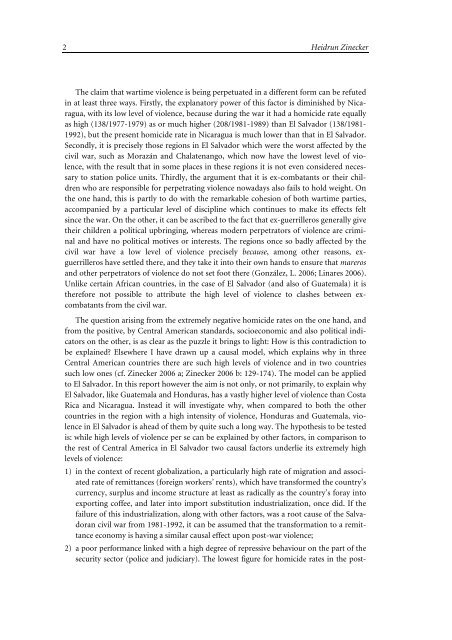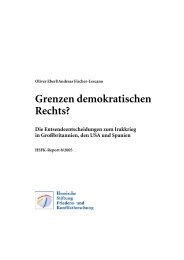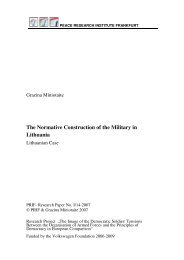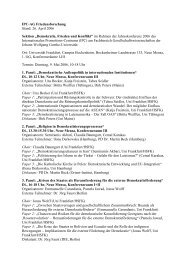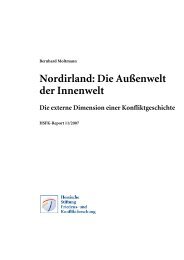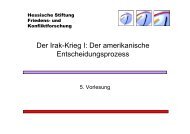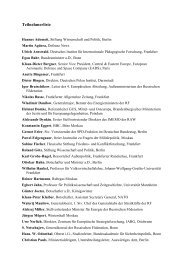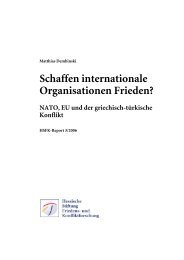From Exodus to Exitus Causes of post-war violence in El ... - eDoc
From Exodus to Exitus Causes of post-war violence in El ... - eDoc
From Exodus to Exitus Causes of post-war violence in El ... - eDoc
You also want an ePaper? Increase the reach of your titles
YUMPU automatically turns print PDFs into web optimized ePapers that Google loves.
2 Heidrun Z<strong>in</strong>ecker<br />
The claim that <strong>war</strong>time <strong>violence</strong> is be<strong>in</strong>g perpetuated <strong>in</strong> a different form can be refuted<br />
<strong>in</strong> at least three ways. Firstly, the explana<strong>to</strong>ry power <strong>of</strong> this fac<strong>to</strong>r is dim<strong>in</strong>ished by Nicaragua,<br />
with its low level <strong>of</strong> <strong>violence</strong>, because dur<strong>in</strong>g the <strong>war</strong> it had a homicide rate equally<br />
as high (138/1977-1979) as or much higher (208/1981-1989) than <strong>El</strong> Salvador (138/1981-<br />
1992), but the present homicide rate <strong>in</strong> Nicaragua is much lower than that <strong>in</strong> <strong>El</strong> Salvador.<br />
Secondly, it is precisely those regions <strong>in</strong> <strong>El</strong> Salvador which were the worst affected by the<br />
civil <strong>war</strong>, such as Morazán and Chalatenango, which now have the lowest level <strong>of</strong> <strong>violence</strong>,<br />
with the result that <strong>in</strong> some places <strong>in</strong> these regions it is not even considered necessary<br />
<strong>to</strong> station police units. Thirdly, the argument that it is ex-combatants or their children<br />
who are responsible for perpetrat<strong>in</strong>g <strong>violence</strong> nowadays also fails <strong>to</strong> hold weight. On<br />
the one hand, this is partly <strong>to</strong> do with the remarkable cohesion <strong>of</strong> both <strong>war</strong>time parties,<br />
accompanied by a particular level <strong>of</strong> discipl<strong>in</strong>e which cont<strong>in</strong>ues <strong>to</strong> make its effects felt<br />
s<strong>in</strong>ce the <strong>war</strong>. On the other, it can be ascribed <strong>to</strong> the fact that ex-guerrilleros generally give<br />
their children a political upbr<strong>in</strong>g<strong>in</strong>g, whereas modern perpetra<strong>to</strong>rs <strong>of</strong> <strong>violence</strong> are crim<strong>in</strong>al<br />
and have no political motives or <strong>in</strong>terests. The regions once so badly affected by the<br />
civil <strong>war</strong> have a low level <strong>of</strong> <strong>violence</strong> precisely because, among other reasons, exguerrilleros<br />
have settled there, and they take it <strong>in</strong><strong>to</strong> their own hands <strong>to</strong> ensure that mareros<br />
and other perpetra<strong>to</strong>rs <strong>of</strong> <strong>violence</strong> do not set foot there (González, L. 2006; L<strong>in</strong>ares 2006).<br />
Unlike certa<strong>in</strong> African countries, <strong>in</strong> the case <strong>of</strong> <strong>El</strong> Salvador (and also <strong>of</strong> Guatemala) it is<br />
therefore not possible <strong>to</strong> attribute the high level <strong>of</strong> <strong>violence</strong> <strong>to</strong> clashes between excombatants<br />
from the civil <strong>war</strong>.<br />
The question aris<strong>in</strong>g from the extremely negative homicide rates on the one hand, and<br />
from the positive, by Central American standards, socioeconomic and also political <strong>in</strong>dica<strong>to</strong>rs<br />
on the other, is as clear as the puzzle it br<strong>in</strong>gs <strong>to</strong> light: How is this contradiction <strong>to</strong><br />
be expla<strong>in</strong>ed? <strong>El</strong>sewhere I have drawn up a causal model, which expla<strong>in</strong>s why <strong>in</strong> three<br />
Central American countries there are such high levels <strong>of</strong> <strong>violence</strong> and <strong>in</strong> two countries<br />
such low ones (cf. Z<strong>in</strong>ecker 2006 a; Z<strong>in</strong>ecker 2006 b: 129-174). The model can be applied<br />
<strong>to</strong> <strong>El</strong> Salvador. In this report however the aim is not only, or not primarily, <strong>to</strong> expla<strong>in</strong> why<br />
<strong>El</strong> Salvador, like Guatemala and Honduras, has a vastly higher level <strong>of</strong> <strong>violence</strong> than Costa<br />
Rica and Nicaragua. Instead it will <strong>in</strong>vestigate why, when compared <strong>to</strong> both the other<br />
countries <strong>in</strong> the region with a high <strong>in</strong>tensity <strong>of</strong> <strong>violence</strong>, Honduras and Guatemala, <strong>violence</strong><br />
<strong>in</strong> <strong>El</strong> Salvador is ahead <strong>of</strong> them by quite such a long way. The hypothesis <strong>to</strong> be tested<br />
is: while high levels <strong>of</strong> <strong>violence</strong> per se can be expla<strong>in</strong>ed by other fac<strong>to</strong>rs, <strong>in</strong> comparison <strong>to</strong><br />
the rest <strong>of</strong> Central America <strong>in</strong> <strong>El</strong> Salvador two causal fac<strong>to</strong>rs underlie its extremely high<br />
levels <strong>of</strong> <strong>violence</strong>:<br />
1) <strong>in</strong> the context <strong>of</strong> recent globalization, a particularly high rate <strong>of</strong> migration and associated<br />
rate <strong>of</strong> remittances (foreign workers’ rents), which have transformed the country’s<br />
currency, surplus and <strong>in</strong>come structure at least as radically as the country’s foray <strong>in</strong><strong>to</strong><br />
export<strong>in</strong>g c<strong>of</strong>fee, and later <strong>in</strong><strong>to</strong> import substitution <strong>in</strong>dustrialization, once did. If the<br />
failure <strong>of</strong> this <strong>in</strong>dustrialization, along with other fac<strong>to</strong>rs, was a root cause <strong>of</strong> the Salvadoran<br />
civil <strong>war</strong> from 1981-1992, it can be assumed that the transformation <strong>to</strong> a remittance<br />
economy is hav<strong>in</strong>g a similar causal effect upon <strong>post</strong>-<strong>war</strong> <strong>violence</strong>;<br />
2) a poor performance l<strong>in</strong>ked with a high degree <strong>of</strong> repressive behaviour on the part <strong>of</strong> the<br />
security sec<strong>to</strong>r (police and judiciary). The lowest figure for homicide rates <strong>in</strong> the <strong>post</strong>-


